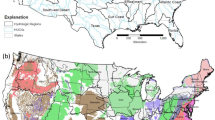Abstract
To examine the preferences of experts to selected economic and policy options in ground-water protection, we conducted an exploratory survey. We presented a group of 120 experts with an analysis of the problem of radium in drinking water supplies of Iowa, and requested their response to a variety of formal questions pertaining to specific issues related to the presence of radium in drinking water. Ninety-seven of the 120 responded. We observed definite preferences in responses to certain aspects of the problem, although in some cases their responses differed significantly due to such factors as length of ground-water related professional experience and residential status. When the presence of excessive radium in drinking water is identified, the respondents preferred immediate action in a world of incomplete knowledge over extensive future research; were willing to undertake personal action to seek radium-free water rather than wait for official action; and favoured local and state government involvement over federal intervention. Findings based on such exploratory surveys can be of much value in defining insightful research hypotheses for field testing. Confirmatory testing of such hypotheses to establish actual preferences in communities with excessive radium in drinking water is a valuable area for further research.
Similar content being viewed by others
References
Bean, J.A., Isacson, P., Hahne, R.M.A. and Kohler, J. 1982. Drinking water and cancer incidence in Iowa: II. Radioactivity in drinking water.Am. J. Epidemiol.,116(6), 924–932.
Gumerman, R.C., Barris, B.E. and Hansen, S.P. 1983.Estimation of Small System Water Treatment Costs. EPA-600/2-84-184a, 503 pp. US Environmental Protection Agency, Cincinnati, Ohio.
Environews Inc. 1987. Researcher studies impact of radon information.Environmental Health Letter,26(22), 5–6.
Hallenbeck, W.H. 1989. Risk analysis of exposure to radium-226/228 in groundwater.The Environmental Professional,11(2), 171–177.
Hansen, S.P., Gumerman, R.C. and Culp, R.L. 1979.Estimating Water Treatment Costs. Volume 3. Cost Curves Applicable to 2, 500 gpd to I mgd Treatment Plants. EPA-600/2-79-162C, 178 pp. US Environmental Protection Agency, Cincinnati, Ohio.
Hileman, B. 1983. Indoor air pollution.Environ. Science Technol.,17(10), 469A-472A.
Iowa Administrative Code, 1983. Chapter 41Water Supplies. State of Iowa. Des Moines, Iowa.
Kriege, L.B. and Hahne, R.M.A. 1982. 226Ra and 228Ra in Iowa drinking water.Health Physics,43(4), 543–559.
Kristoff, L.M., Lordi, D.T. and Lue-Hing, C. 1990. Radium-226 and tritium in public well supplies of the Greater Chicago area.Journal AWWA,82(3), 77–82.
Lyman, G.H., Lyrnan, C.G. and Johnson, W. 1985. Association of leukemia with radium groundwater contamination.J. Am. Medical Assoc.,254(5), 621–626.
Michel, J. and Cothern, C.R. 1986. Predicting the occurrence of228Ra in groundwater.Health Physics,51(6), 715–721.
Michel, J. and Moore, W.S. 1980.228Ra and226Ra content of groundwater in fall line aquifers.Health Physics,38(2), 663–671.
Milvy, P. and Cothern, C.R. 1989. Naturally occurring radionuclides in drinking water: an exercise in risk benefit analysis.Environ. Geochem. Health,11(2): 63–72.
National Research Council. 1977.Drinking Water and Public Health. Volume 1. Safe Drinking Water Committee, National Academy Press, Washington, DC.
Peterson, N.J., Samuels, L.D., Lucas, H.F. and Abrahams, S.P. 1966.An Epidemiologie Approach to Low-Level Radium-226 Exposure. Public Health Repon. No.81, 805–814.
Rowland, R.E., Lucas, H.F. Jr. and Stehney, A.F. 1977. High radium levels in the water supplies of Illinois and Iowa, In: T.L. Cullen and L.P. Franca (eds.).Proceedings of the Symposium on Areas of High Natural Radioactivity. Academia Brasileira de Ciencias, Rio de Janeiro, Brasil.
Waters, W.P., Rajagopal, R. and Pitchford, A.M. 1987. Ground water quality protection: a case of management by exception. In:Proceedings of the Symposium on Monitoring, Modeling, and Mediating Water Quality, pp. 693–707. Published by the AWRA. Syracuse, NY.
Author information
Authors and Affiliations
Rights and permissions
About this article
Cite this article
Rajagopal, R., Tobin, G. Radioactivity in drinking water: Expert opinion and policy choices. Environ Geochem Health 12, 267–276 (1990). https://doi.org/10.1007/BF01783451
Received:
Accepted:
Issue Date:
DOI: https://doi.org/10.1007/BF01783451




